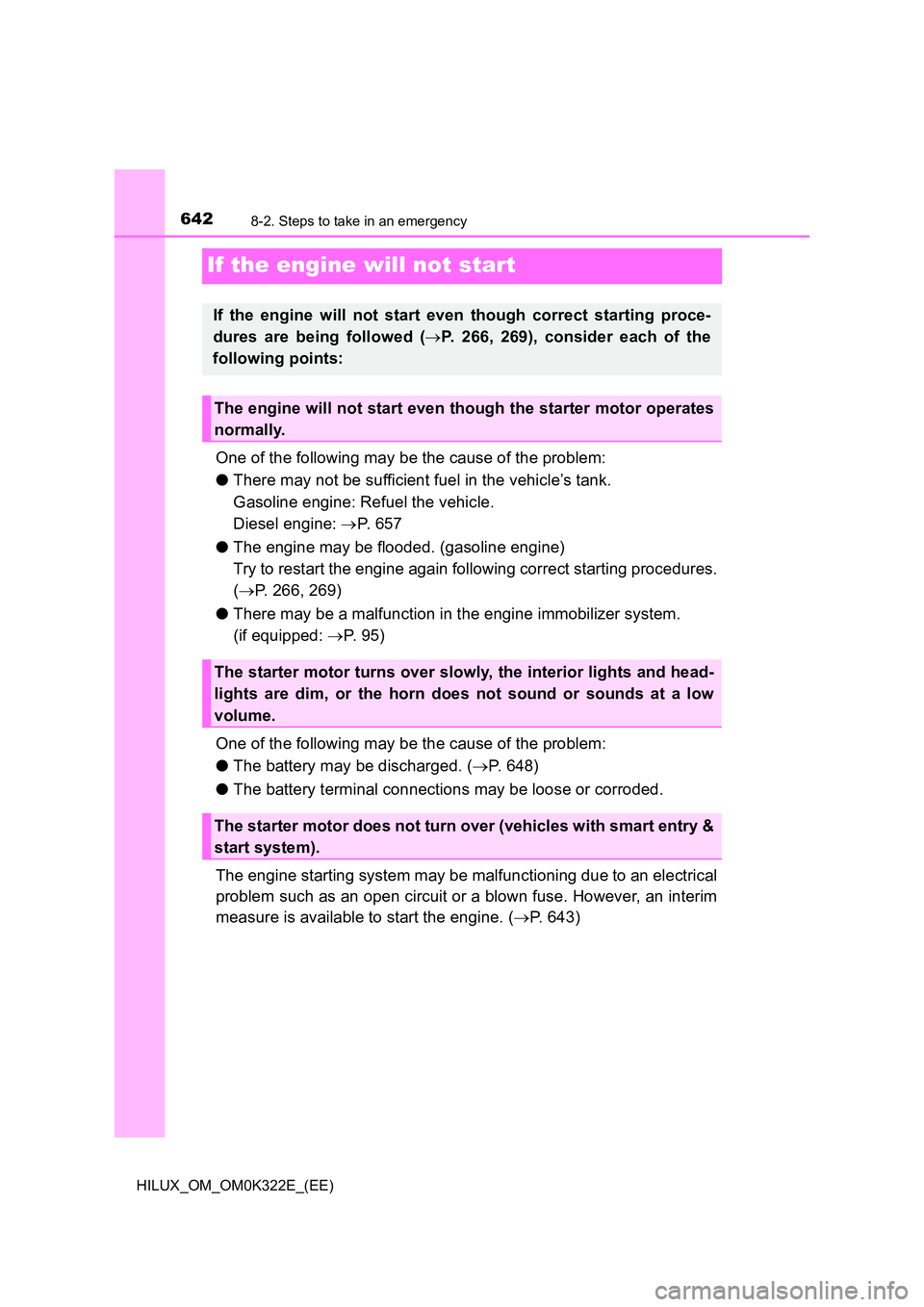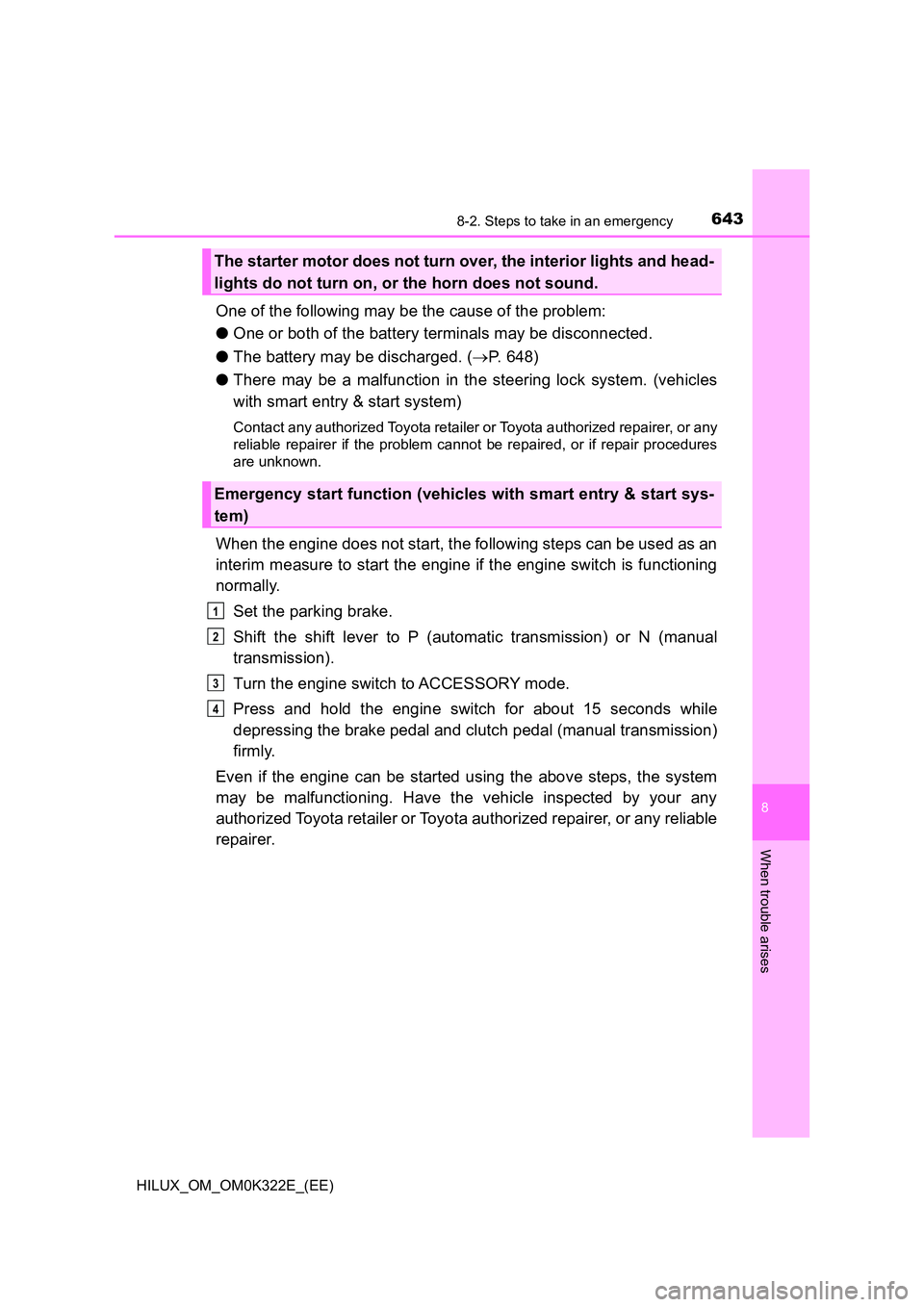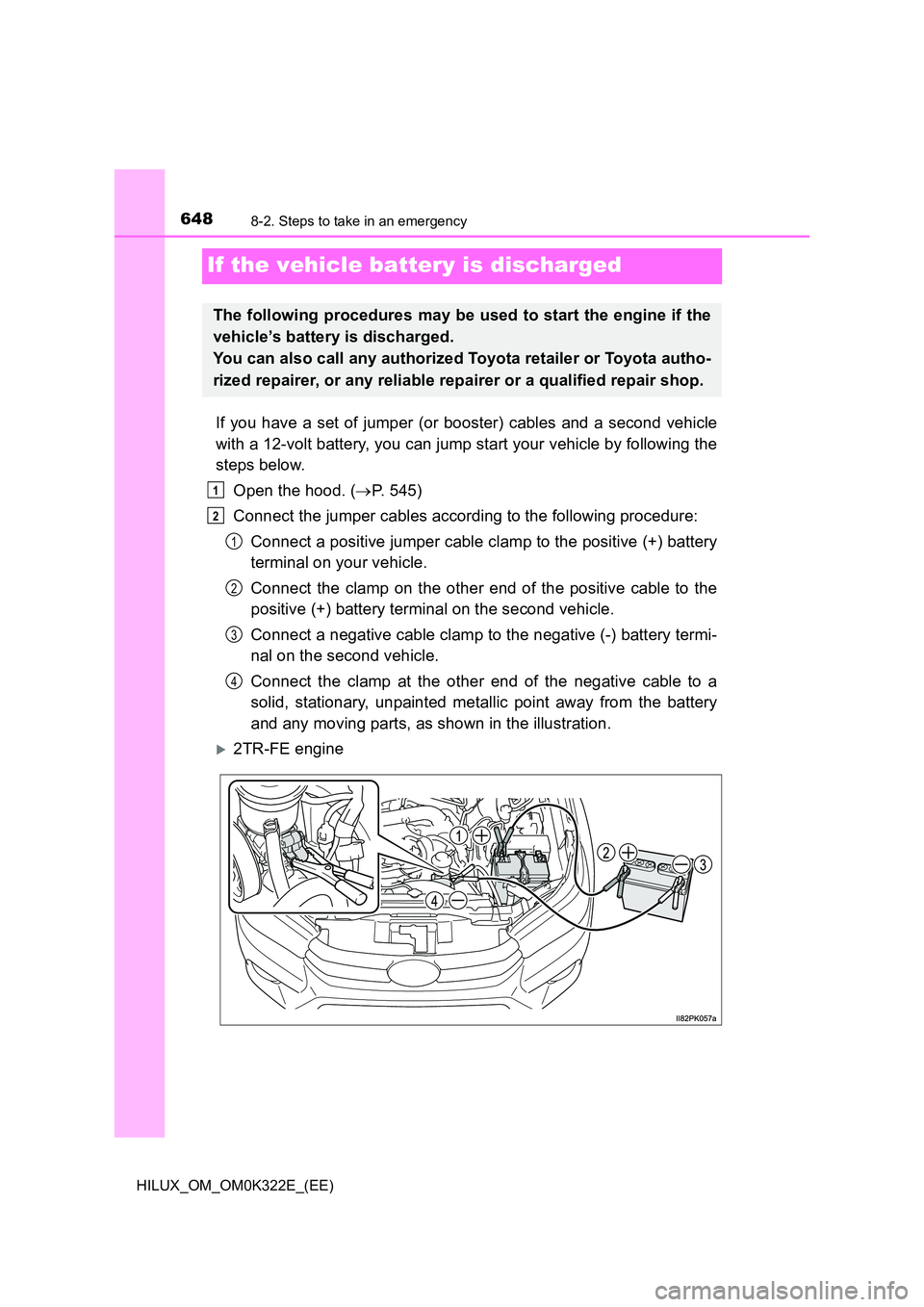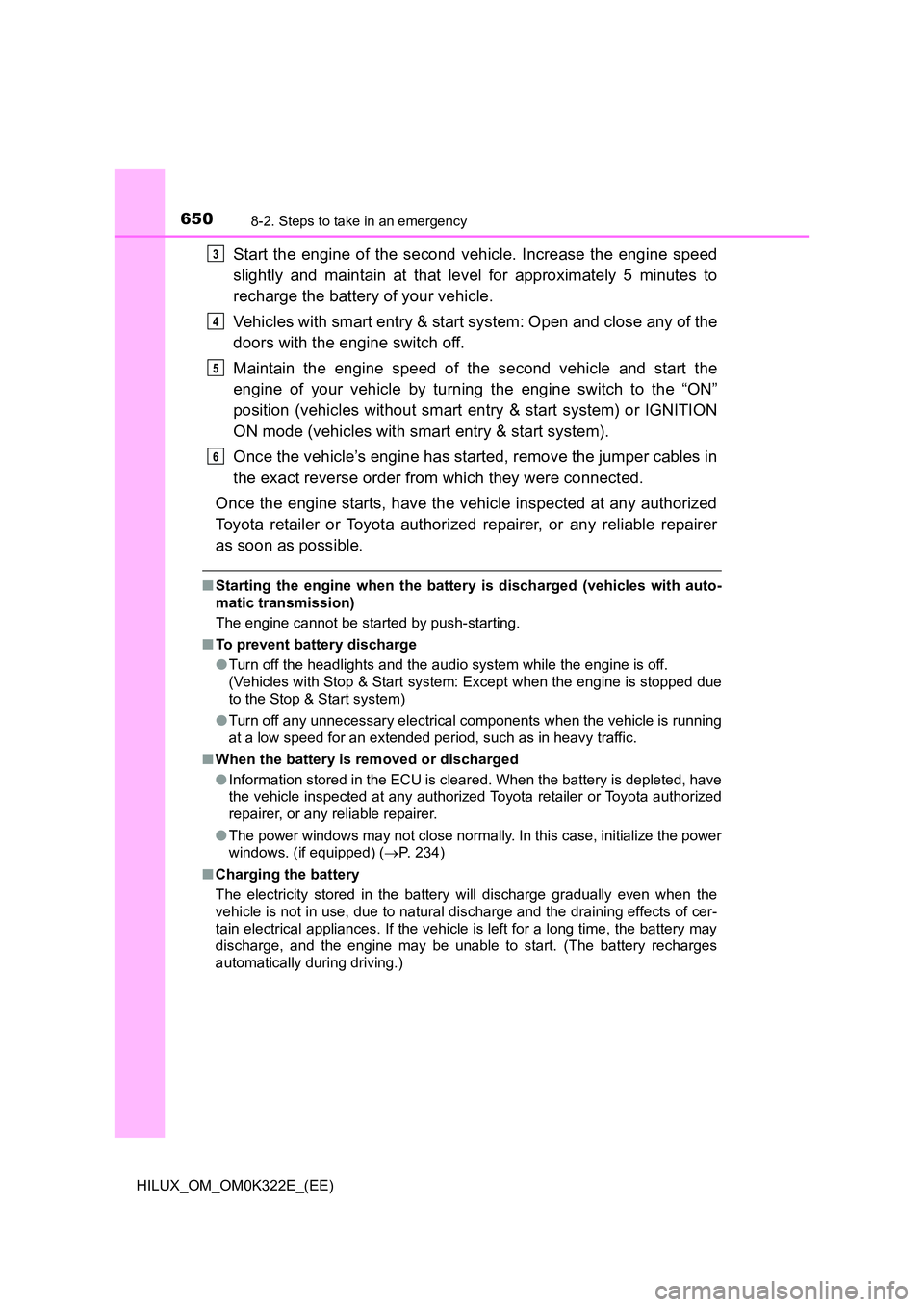Page 600 of 720
6008-1. Essential information
HILUX_OM_OM0K322E_(EE)
Emergency flashers
Press the switch.
All the turn signal lights will flash.
To turn them off, press the switch
once again.
■ Emergency flashers
If the emergency flashers are used for a long time while the engine is not
operating, the battery may discharge.
The emergency flashers are used to warn other drivers when the
vehicle has to be stopped in the road due to a breakdown, etc.
Page 621 of 720

6218-2. Steps to take in an emergency
HILUX_OM_OM0K322E_(EE)
8
When trouble arises
■If “T-BELT MAINTENANCE REQUIRED”/“T-BELT maintenance required”
is shown on the multi-information display
The timing belt is scheduled to be changed.
Have the timing belt checked and/or changed by any authorized Toyota
retailer or Toyota authorized repairer, or any reliable repairer.
■ If “DIFFERENTIAL OIL TEMP HIGH COOLING TIME REQUIRED”/“Diffe-
rential oil temp high Cooling time required” is shown on the multi-infor-
mation display
The differential oil temperature is too high.
Wait until the warning message goes off.
■ If “ENGINE OIL LEVEL LOW ADD OR REPLACE”/“Engine oil level low
Add or replace” is shown on the multi-information display
The engine oil level is low. (This warning message may be displayed if the
vehicle is stopped on a slope. Move to a level surface and check to see if the
message goes off.)
Check the level of the engine oil and add or replace oil if necessary.
( P. 540)
■ If “POWER TURNED OFF TO SAVE BATTERY”/“Power turned off to save
battery” is shown on the multi-information display
Power was turned off due to the automatic power off function.
Next time when starting the engine, increase the engine speed slightly and
maintain that level for approximately 5 minutes to recharge the battery.
Page 642 of 720

6428-2. Steps to take in an emergency
HILUX_OM_OM0K322E_(EE)
If the engine will not start
One of the following may be the cause of the problem:
● There may not be sufficient fuel in the vehicle’s tank.
Gasoline engine: Refuel the vehicle.
Diesel engine: P. 6 5 7
● The engine may be flooded. (gasoline engine)
Try to restart the engine again following correct starting procedures.
( P. 266, 269)
● There may be a malfunction in the engine immobilizer system.
(if equipped: P. 95)
One of the following may be the cause of the problem:
● The battery may be discharged. (P. 648)
● The battery terminal connections may be loose or corroded.
The engine starting system may be malfunctioning due to an electrical
problem such as an open circuit or a blown fuse. However, an interim
measure is available to start the engine. ( P. 643)
If the engine will not start even though correct starting proce-
dures are being followed ( P. 266, 269), consider each of the
following points:
The engine will not start even though the starter motor operates
normally.
The starter motor turns over slowly, the interior lights and head-
lights are dim, or the horn does not sound or sounds at a low
volume.
The starter motor does not turn over (vehicles with smart entry &
start system).
Page 643 of 720

6438-2. Steps to take in an emergency
HILUX_OM_OM0K322E_(EE)
8
When trouble arises
One of the following may be the cause of the problem:
● One or both of the battery terminals may be disconnected.
● The battery may be discharged. (P. 648)
● There may be a malfunction in the steering lock system. (vehicles
with smart entry & start system)
Contact any authorized Toyota retailer or Toyota authorized repairer, or any
reliable repairer if the problem cannot be repaired, or if repair procedures
are unknown.
When the engine does not start, the following steps can be used as an
interim measure to start the engine if the engine switch is functioning
normally.
Set the parking brake.
Shift the shift lever to P (automatic transmission) or N (manual
transmission).
Turn the engine switch to ACCESSORY mode.
Press and hold the engine switch for about 15 seconds while
depressing the brake pedal and clutch pedal (manual transmission)
firmly.
Even if the engine can be started using the above steps, the system
may be malfunctioning. Have the vehicle inspected by your any
authorized Toyota retailer or Toyota authorized repairer, or any reliable
repairer.
The starter motor does not turn over, the interior lights and head-
lights do not turn on, or the horn does not sound.
Emergency start function (vehicles with smart entry & start sys-
tem)
1
2
3
4
Page 644 of 720
6448-2. Steps to take in an emergency
HILUX_OM_OM0K322E_(EE)
If the electronic key does not operate properly
(vehicles with smart entry & start system)
Use the mechanical key (P. 155)
in order to perform the following
operations:
Locks all doors
Unlocks all doors
If communication between the electronic key and vehicle is
interrupted ( P. 187) or the electronic key cannot be used
because the battery is depleted, the smart entry & start system
and wireless remote control cannot be used. In such cases, the
doors can be opened and the engine can be started by following
the procedure below.
Locking and unlocking the doors
1
2
Page 647 of 720

6478-2. Steps to take in an emergency
HILUX_OM_OM0K322E_(EE)
8
When trouble arises
■Stopping the engine
Shift the shift lever to P (automatic transmission) or N (manual transmission)
and press the engine switch as you normally do when stopping the engine.
■ Replacing the key battery
As the above procedure is a temporary measure, it is recommended that the
electronic key battery be replaced immediately when the battery is depleted.
( P. 575)
■ Alarm (vehicles with alarm for Kazakhstan, Armenia, Georgia,
Turkmenistan and Morocco)
Using the mechanical key to lock the doors will not set the alarm system.
If a door is unlocked using the mechanical key when the alarm system is set,
the alarm may be triggered.
■ Changing engine switch modes
Release the brake pedal (automatic transmission) or clutch pedal (manual
transmission) and press the engine switch in step above.
The engine does not start and modes will be changed each time the switch is
pressed. ( P. 272)
■ When the electronic key does not work properly
● Make sure that the smart entry & start system has not been deactivated in
the customization setting. If it is off, turn the function on.
(Customizable features: P. 695)
● Check if battery-saving mode is set. If it is set, cancel the function.
( P. 185)
3
Page 648 of 720

6488-2. Steps to take in an emergency
HILUX_OM_OM0K322E_(EE)
If the vehicle battery is discharged
If you have a set of jumper (or booster) cables and a second vehicle
with a 12-volt battery, you can jump start your vehicle by following the
steps below.
Open the hood. ( P. 545)
Connect the jumper cables according to the following procedure:
Connect a positive jumper cable clamp to the positive (+) battery
terminal on your vehicle.
Connect the clamp on the other end of the positive cable to the
positive (+) battery terminal on the second vehicle.
Connect a negative cable clamp to the negative (-) battery termi-
nal on the second vehicle.
Connect the clamp at the other end of the negative cable to a
solid, stationary, unpainted metallic point away from the battery
and any moving parts, as shown in the illustration.
2TR-FE engine
The following procedures may be used to start the engine if the
vehicle’s battery is discharged.
You can also call any authorized Toyota retailer or Toyota autho-
rized repairer, or any reliable repairer or a qualified repair shop.
1
2
1
2
3
4
Page 650 of 720

6508-2. Steps to take in an emergency
HILUX_OM_OM0K322E_(EE)
Start the engine of the second vehicle. Increase the engine speed
slightly and maintain at that level for approximately 5 minutes to
recharge the battery of your vehicle.
Vehicles with smart entry & start system: Open and close any of the
doors with the engine switch off.
Maintain the engine speed of the second vehicle and start the
engine of your vehicle by turning the engine switch to the “ON”
position (vehicles without smart entry & start system) or IGNITION
ON mode (vehicles with smart entry & start system).
Once the vehicle’s engine has started, remove the jumper cables in
the exact reverse order from which they were connected.
Once the engine starts, have the vehicle inspected at any authorized
Toyota retailer or Toyota authorized repairer, or any reliable repairer
as soon as possible.
■ Starting the engine when the battery is discharged (vehicles with auto-
matic transmission)
The engine cannot be started by push-starting.
■ To prevent battery discharge
● Turn off the headlights and the audio system while the engine is off.
(Vehicles with Stop & Start system: Except when the engine is stopped due
to the Stop & Start system)
● Turn off any unnecessary electrical components when the vehicle is running
at a low speed for an extended period, such as in heavy traffic.
■ When the battery is removed or discharged
● Information stored in the ECU is cleared. When the battery is depleted, have
the vehicle inspected at any authorized Toyota retailer or Toyota authorized
repairer, or any reliable repairer.
● The power windows may not close normally. In this case, initialize the power
windows. (if equipped) ( P. 234)
■ Charging the battery
The electricity stored in the battery will discharge gradually even when the
vehicle is not in use, due to natural discharge and the draining effects of cer-
tain electrical appliances. If the vehicle is left for a long time, the battery may
discharge, and the engine may be unable to start. (The battery recharges
automatically during driving.)
3
4
5
6